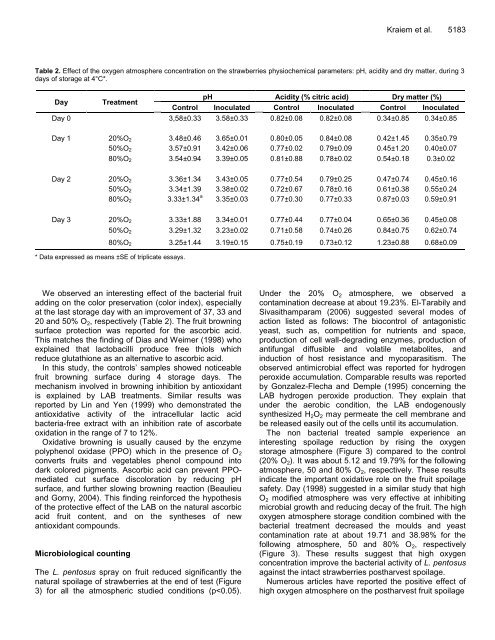Microbiology Research - Academic Journals
Microbiology Research - Academic Journals
Microbiology Research - Academic Journals
Create successful ePaper yourself
Turn your PDF publications into a flip-book with our unique Google optimized e-Paper software.
Kraiem et al. 5183<br />
Table 2. Effect of the oxygen atmosphere concentration on the strawberries physiochemical parameters: pH, acidity and dry matter, during 3<br />
days of storage at 4°C*.<br />
Day Treatment<br />
pH Acidity (% citric acid) Dry matter (%)<br />
Control Inoculated Control Inoculated Control Inoculated<br />
Day 0 3,58±0.33 3.58±0.33 0.82±0.08 0.82±0.08 0.34±0.85 0.34±0.85<br />
Day 1 20%O2 3.48±0.46 3.65±0.01 0.80±0.05 0.84±0.08 0.42±1.45 0.35±0.79<br />
50%O2 3.57±0.91 3.42±0.06 0.77±0.02 0.79±0.09 0.45±1.20 0.40±0.07<br />
80%O2 3.54±0.94 3.39±0.05 0.81±0.88 0.78±0.02 0.54±0.18 0.3±0.02<br />
Day 2 20%O2 3.36±1.34 3.43±0.05 0.77±0.54 0.79±0.25 0.47±0.74 0.45±0.16<br />
50%O2 3.34±1.39 3.38±0.02 0.72±0.67 0.78±0.16 0.61±0.38 0.55±0.24<br />
80%O2 3.33±1.34 a 3.35±0.03 0.77±0.30 0.77±0.33 0.87±0.03 0.59±0.91<br />
Day 3 20%O2 3.33±1.88 3.34±0.01 0.77±0.44 0.77±0.04 0.65±0.36 0.45±0.08<br />
50%O2 3.29±1.32 3.23±0.02 0.71±0.58 0.74±0.26 0.84±0.75 0.62±0.74<br />
80%O2 3.25±1.44 3.19±0.15 0.75±0.19 0.73±0.12 1.23±0.88 0.68±0.09<br />
* Data expressed as means ±SE of triplicate essays.<br />
We observed an interesting effect of the bacterial fruit<br />
adding on the color preservation (color index), especially<br />
at the last storage day with an improvement of 37, 33 and<br />
20 and 50% O2, respectively (Table 2). The fruit browning<br />
surface protection was reported for the ascorbic acid.<br />
This matches the finding of Dias and Weimer (1998) who<br />
explained that lactobacilli produce free thiols which<br />
reduce glutathione as an alternative to ascorbic acid.<br />
In this study, the controls’ samples showed noticeable<br />
fruit browning surface during 4 storage days. The<br />
mechanism involved in browning inhibition by antioxidant<br />
is explained by LAB treatments. Similar results was<br />
reported by Lin and Yen (1999) who demonstrated the<br />
antioxidative activity of the intracellular lactic acid<br />
bacteria-free extract with an inhibition rate of ascorbate<br />
oxidation in the range of 7 to 12%.<br />
Oxidative browning is usually caused by the enzyme<br />
polyphenol oxidase (PPO) which in the presence of O2<br />
converts fruits and vegetables phenol compound into<br />
dark colored pigments. Ascorbic acid can prevent PPOmediated<br />
cut surface discoloration by reducing pH<br />
surface, and further slowing browning reaction (Beaulieu<br />
and Gorny, 2004). This finding reinforced the hypothesis<br />
of the protective effect of the LAB on the natural ascorbic<br />
acid fruit content, and on the syntheses of new<br />
antioxidant compounds.<br />
Microbiological counting<br />
The L. pentosus spray on fruit reduced significantly the<br />
natural spoilage of strawberries at the end of test (Figure<br />
3) for all the atmospheric studied conditions (p

















